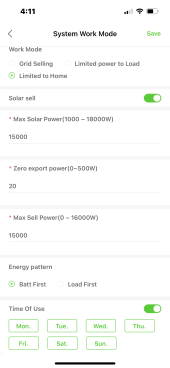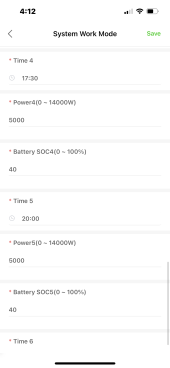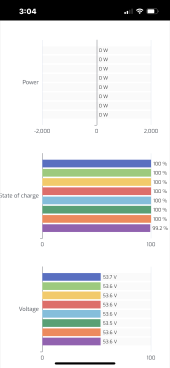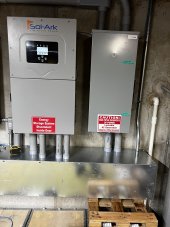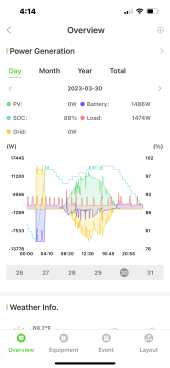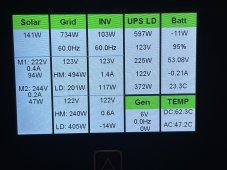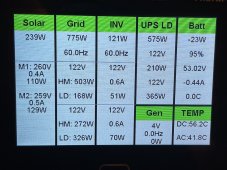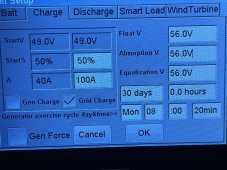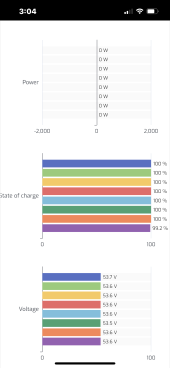I'm trying to figure out a problem with my Sol-Ark setup, but since this is my first post, I must first give a bit of background. We recently had a solar system installed by a professional installer. So it's not DIY, and I can't claim to be expert in anything about it. I understand the concepts of how it's done, but I didn't do it, and I didn't really watch the electrician either. So there may be questions that I'd have to hunt to find an answer to.
It's a 23+ KW system with two Sol-Ark 12K inverters and 20 kWh worth of Storz-Power batteries. This is a grid tie system. The grid feed comes in as two 200A feeds off a single meter outside, with each feed going to a separate breaker box in the house. The electricians added a third breaker box for critical loads and moved a few things over to it (fridge, freezer, some lights, etc). The system seems to work pretty good except for one thing.
Which brings me to the problem. I have the TOU set up to use batteries at night, then recharge from solar during the day, then send any excess back to the grid (solar sell). If they don't make it to full charge, I have it set to charge from the grid at 3 in the afternoon. On cloudy days, everything works just peachy. But on sunny days, it will throw an F18 AC Overcurrent Fault as soon as the batteries hit full charge. Every time. And if that weren't bad enough, it will reset itself and start back up and then immediately fault again. It will repeat this all day until the sun goes low enough, so I get basically no solar input during the day because it's constantly faulting and resetting.
BUT... if I turn TOU *off*, this doesn't happen. The batteries charge up, then it just sends the excess back to the grid just like it's supposed to and everything works fine.
The only way (so far) that I've found to actually make it work like I intend is turn TOU on in the evening, let it use batteries overnight, then in the morning, wait until the batteries are almost full (or let it fault once) then turn TOU off until evening again. Needless to say, this is not optimal.
The electricians who installed it have been out several times and have supposedly talked to Sol-Ark about it, but so far nothing they've done or suggested has helped at all. We've tried various different settings for TOU draw and SOC, but they don't matter. I even set the draw to zero during the day, figuring that would effectively turn it off, but nope -- same fault. If TOU is enabled and it's a sunny day, it will fault when it hits full charge, every time. And it does this even when we're not home, so there's very little power being used in the house at the time (maybe 1 KW or so), so I don't see how it could *really* be overcurrent, but that's the fault it throws. I have stood there and watched it do it. After a reset, I will see the solar input increasing, 1 KW, 2KW, 3 ... etc, and when it hits about 6KW, I hear a "click" like a relay or something, and it faults. I don't know if the click precedes the fault or is caused by it -- to the ear, it sounds like the click is first, then the fault, but it's almost simultaneous.
They've moved the CT sensors around, checked polarities, and so forth, and all seems good.
Since it doesn't happen if TOU is off, I can't help but think this is a software issue -- maybe a setting I have wrong?
Has anyone experienced this?
(And please don't tell me to call the electrician back out here -- I have been doing that, but the fault continues, so I'm trying to figure it out while gathering as much data as I can.)
TOU settings (on both inverters)
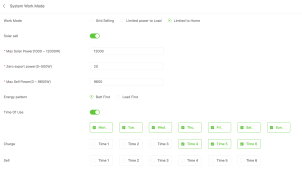

It's a 23+ KW system with two Sol-Ark 12K inverters and 20 kWh worth of Storz-Power batteries. This is a grid tie system. The grid feed comes in as two 200A feeds off a single meter outside, with each feed going to a separate breaker box in the house. The electricians added a third breaker box for critical loads and moved a few things over to it (fridge, freezer, some lights, etc). The system seems to work pretty good except for one thing.
Which brings me to the problem. I have the TOU set up to use batteries at night, then recharge from solar during the day, then send any excess back to the grid (solar sell). If they don't make it to full charge, I have it set to charge from the grid at 3 in the afternoon. On cloudy days, everything works just peachy. But on sunny days, it will throw an F18 AC Overcurrent Fault as soon as the batteries hit full charge. Every time. And if that weren't bad enough, it will reset itself and start back up and then immediately fault again. It will repeat this all day until the sun goes low enough, so I get basically no solar input during the day because it's constantly faulting and resetting.
BUT... if I turn TOU *off*, this doesn't happen. The batteries charge up, then it just sends the excess back to the grid just like it's supposed to and everything works fine.
The only way (so far) that I've found to actually make it work like I intend is turn TOU on in the evening, let it use batteries overnight, then in the morning, wait until the batteries are almost full (or let it fault once) then turn TOU off until evening again. Needless to say, this is not optimal.
The electricians who installed it have been out several times and have supposedly talked to Sol-Ark about it, but so far nothing they've done or suggested has helped at all. We've tried various different settings for TOU draw and SOC, but they don't matter. I even set the draw to zero during the day, figuring that would effectively turn it off, but nope -- same fault. If TOU is enabled and it's a sunny day, it will fault when it hits full charge, every time. And it does this even when we're not home, so there's very little power being used in the house at the time (maybe 1 KW or so), so I don't see how it could *really* be overcurrent, but that's the fault it throws. I have stood there and watched it do it. After a reset, I will see the solar input increasing, 1 KW, 2KW, 3 ... etc, and when it hits about 6KW, I hear a "click" like a relay or something, and it faults. I don't know if the click precedes the fault or is caused by it -- to the ear, it sounds like the click is first, then the fault, but it's almost simultaneous.
They've moved the CT sensors around, checked polarities, and so forth, and all seems good.
Since it doesn't happen if TOU is off, I can't help but think this is a software issue -- maybe a setting I have wrong?
Has anyone experienced this?
(And please don't tell me to call the electrician back out here -- I have been doing that, but the fault continues, so I'm trying to figure it out while gathering as much data as I can.)
TOU settings (on both inverters)






